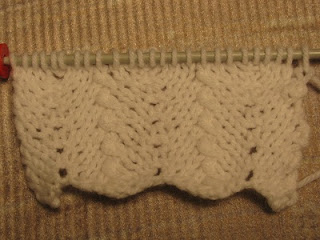K1P1 Ribbing
When you think of K1P1, your first thought is likely K1P1 ribbing, shown in the upper portion of this knitting sample. It is a stitch pattern that is used frequently as a hem treatment. It has a lot of width-wise compression.
The easiest stitch pattern for this is to cast on an even number of stitches, and then repeat Row 1 over and over again:
Row 1: *K1. P1. Rep from * to end.
This stitch pattern is an example of the concept of Knit the Knits and Purl the Purls.
Seed Stitch (aka Moss Stitch)
But this same basic stitch pattern can do much more.This photo shows Seed Stitch in progress.
It feels like K1P1 Ribbing, but you Knit the PURLS and Purl the KNITS instead.
In the photo, the next stitch should be a Knit.
The stitch pattern for Seed Stitch is also a 1-row repeat:
Cast on an odd number of stitches.
Row 1: K1. *P1. K1. Rep from * to end.
Double Moss Stitch
This stitch pattern consists of two rows of ordinary K1P1 ribbing, and then two more rows with the stitches shifted one stitch. There is a lot of texture in the knitted fabric. Here is the stitch pattern - it is a 4-row repeat:
Cast on an even number of stitches:
Row 1: * K1. P1. Rep from * across.
Row 2: Rep Row 1.
Row 3: * P1. K1. Rep from * across.
Row 4: Rep Row 2.
Fleck Stitch
And finally, another variation, this one with a K1P1 row stuffed into the middle of some Stocking Stitch rows.
This pattern stitch also has a 4-row repeat:
Cast on an even number of stitches
Row 1 (RS): Knit.
Row 2: Purl.
Row 3: Knit.
Row 4: * K1. P1. Rep from * across.
Conclusion
This article just touches the surface of what you can do with the simple K1P1 knitted stitch pattern.
For more information, check out the Read Knitting Patterns website.










